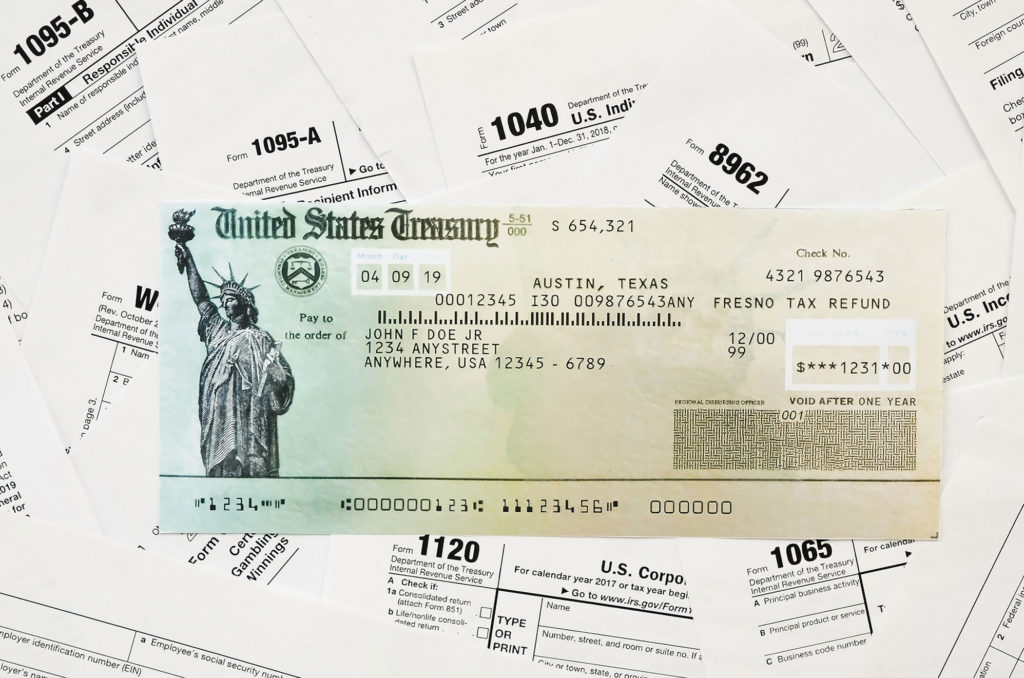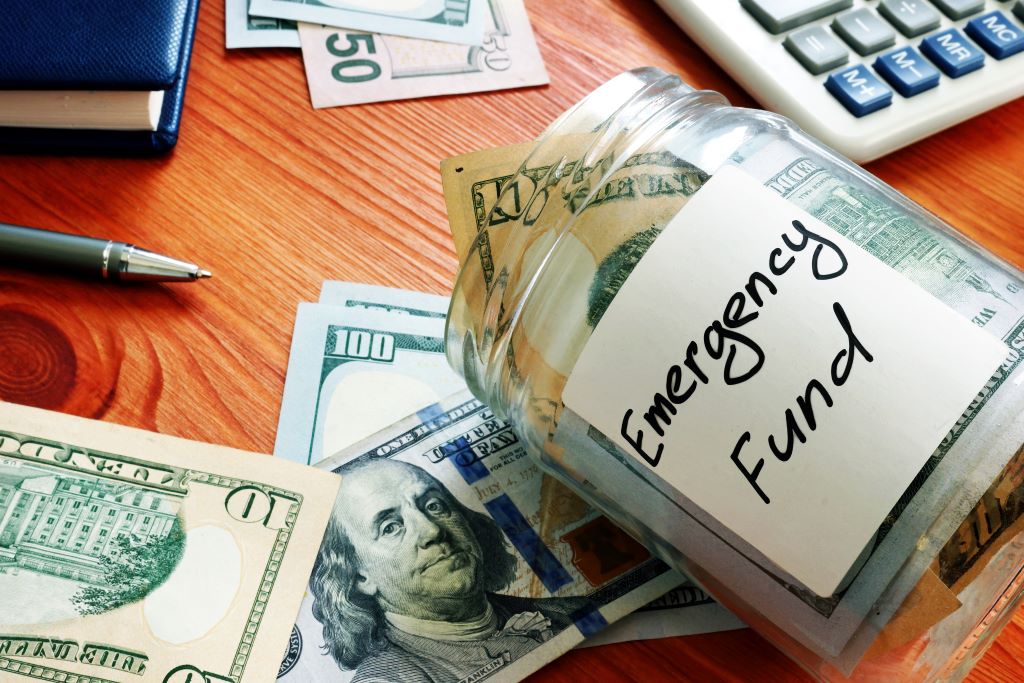
If you’re among the lucky Americans who will get a tax refund this year, it’s essential to plan what you’ll do with it. While a shopping spree or dream vacation sounds fantastic, it’s not the most responsible way to use your money. Since the deadline to file your taxes was earlier this week on Monday, April 15th, we figured now would be the perfect time to share some smart ways you can use your tax refund. So, let’s get started with our list of 12 smart ways you can spend your tax refund.
Consider These 12 Smart Ways to Spend Your Tax Refund
Make the most of your tax refund by considering the following ways to spend it this year.
Use Your Tax Refund to Pay Off Your Debt
High-interest credit card debt can be the worst budget killer. It can keep you from saving for retirement, college, or even an emergency fund. In addition, the compounding interest further increases your debt.
Even if your tax refund doesn’t pay the debt off in full, it can chip away at it. Even a few thousand-dollar payments can save you hundreds in interest and months of expenses.

Set Up an Emergency Fund with Your Tax Refund
Life happens when we least expect it, and sometimes it’s unpleasant. However, situations can be much worse without an emergency fund because of financial stress. Not having the money to fund a major repair, take care of large hospital bills, or cover damages caused by an accident could be devastating.
Going into credit card debt or any other debt only worsens the situation. If you don’t have an emergency fund or have at least six months of expenses set aside, consider using at least some of your tax refund for the emergency fund.
Instead of depositing your tax refund into a standard savings account, consider looking into a high-yield savings account. You may be able to use your tax refund to start an emergency fund in an online high-yield savings account to earn higher interest rates.
Suppose you haven’t started an emergency fund yet. If you can afford it, consider setting aside $1,000. This may get you through basic emergencies without using credit cards, but don’t stop there. Consider keeping your efforts going even after funding your account with some or all of your tax refund.
Invest in Your 401K
401k accounts can be extremely beneficial for some. For example, if your employer matches 3% of your salary dollar-for-dollar and you make $75,000, that’s $2,250 in “free” money. But you must contribute $2,250 for the employer to match it.
Consider using your tax refund money to offset the deductions from your paycheck. By doing this, you can enjoy the “free” $2,250 contribution to your retirement account. It may not sound like much, but with compounding interest, that $2,250 can be worth a lot more in retirement.* Getting in this mindset can help put you closer to your retirement goals.
Invest in an IRA
If you don’t have an employer-sponsored 401K or you maxed it out, consider opening an IRA.* You can contribute up to $7,000 per year in a traditional or Roth IRA.
A traditional IRA gives you a tax deduction this year (or the year you contribute). A Roth IRA gives a tax break during retirement. You pay the taxes at your current tax rate, but your contributions and earnings grow tax-free.
Any money you invest in an IRA must sit until you are 59 ½ years old. If you withdraw the funds early, you’ll pay a 10% penalty for most cases, plus any applicable taxes.
Invest in a Taxable Account
If you’ve maxed out your 401K and IRA contributions, consider investing in a taxable account. You don’t need much money to invest. In some cases, you may even get by with $100 or less to open an account.
Consider trying a robo-advisor like Wealthfront, Betterment, or Robinhood.* They often have low minimum balance requirements. You may not even have to know much about investing to get started. After you answer basic questions about your goals, they help create and manage a portfolio for you. Although many people have found their services to be affordable, always make sure that you first understand all of the applicable terms and fees.
A taxable account doesn’t offer tax breaks like a retirement account. So, you can typically use the funds as needed, withdrawing from your account at any time without penalty. However, watch out for the tax liability they incur if you have capital gains.
Pay Down Your Student Loans with Your Tax Refund
Student loan debt can follow you for many years, costing you thousands in interest.* Consider paying your balance. You could save thousands of dollars in interest and even pay your loans off faster. Student loans can get in the way of getting approved for a mortgage or even saving for a down payment on a house. While it may not be what you want to do with the funds, paying down your student loans can put more money in your pocket.

Save for a Down Payment on a House
If you aren’t a homeowner, consider using your tax refund to start your fund for your down payment. Today, there are many options available to new homeowners, and you don’t always need a 20% down payment. You may get by with putting much less down with an FHA loan, for example.*
If you already have a down payment saved, your tax refund can help cover the closing costs, which typically range between 2-5% of the loan amount. For example, if you borrow $200,000, your closing costs can be anywhere from $4,000 – $10,000, in addition to the down payment.
Pay Extra Mortgage Principal
If you’re a homeowner, consider paying your mortgage balance down with your tax refund. Like student loans, if you pay the principal balance down faster, the loan accumulates less interest. Depending on how much principal you pay down, you may even cut years off your mortgage.
Since most mortgage loans are for 15-30 years, you could own your home free and clear much faster. Consider the benefits if you make a lump sum payment or pay an additional $100+ per month toward your principal over a few years.
Open a 529 Savings Plan with Your Tax Refund
If your kids are college-bound, or you think they may be, invest in a 529 Savings Plan.* Each state has different options with different tax benefits. Always check your state first because you’ll get the most tax benefits there but explore other state options to compare your options.
The 529 Savings Plan funds grow tax-free, and if you use the funds for eligible educational expenses, you pay no taxes. If your child doesn’t attend a university or 4-year college, you can use the funds for any ‘eligible’ education expenses, including trade school, community college, and even K-12 expenses.

Invest in Yourself
Don’t leave yourself out of the equation when you think of investing. You can invest in yourself in many ways:
- Go back to school.
- Get certification for your job or industry.
- Get a degree to get a promotion at your current job.
Invest in Your Home
If you own a home, using your tax refund to invest in your home may give you the greatest return. Consider making improvements that increase a home’s value, such as minor kitchen and bathroom remodels, upgrading your home’s curb appeal, or adding a deck or patio.
Before you invest, talk to a real estate agent or licensed appraiser to see how much the intended repairs or renovations will improve your home’s value.
Start a Business
Use your tax refund if you’ve always dreamed of starting your own business. You don’t have to leave your job to start a business – start something on the side and see how it goes. If it grows enough that you can make it your full-time employment, go for it. Otherwise, consider using the money from your side hustle to reach your goals.
Bottom Line
Think about where your tax refund would do the best in your life. Both are great places to start if you haven’t saved a penny in your emergency fund or for retirement. If you’re all set in those areas, branch out and look at other avenues, so you can invest your money.
Even if you split the refund up among a couple of investments or areas of your life, putting the money to good use is crucial. You’ll get the most bang for your buck and give yourself a head start on creating your desired future.
*High-interest loans can be expensive and should be used only for short-term financial needs, not long-term solutions. Customers with credit difficulties should seek credit counseling. The opinions expressed above are solely the author’s views and may or may not reflect the opinions and beliefs of the website or its affiliates. Cash Factory USA does not provide financial advice.
This blog contains links to other third-party websites that are not endorsed by, directly affiliated with, or sponsored by Cash Factory USA. Such links are only for the convenience of the reader, user, or browser.